|
Thermodynamic databases
Thermotech produces a number of databases for use with thermodynamical calculation software packages. They are an integral part of JMatPro and can be used with JMatPro's own thermodynamical calculation engine. The databases can also be used with third party software such as Thermo-Calc. The databases are used by a wide range of major international companies working in Materials Engineering and Production as well as universities. Their success is firmly based on the capability to work with "real" materials which are multi-component in nature and exhibit complex behaviour. The following databases are available: Al-DATA
Al, B, C, Ca, Cr, Cu, Fe, H, La, Mg, Mn, Ni, Sc, Si, Sr, Ti, V, Zn, Zr
with data for the following phases.
 As well as providing excellent predictions for basic phase equilibria studies for most of the major types of Aluminium alloy it has been highly successful in modelling complex non-equilibrium solidification. It can also be used as a prime source of thermophysical data for input into solidification modelling packages. The figures underneath show a comparison between experimental and simulated cooling curves for a 356/LM25 alloy using latent heat and fraction solid vs. temp. data obtained from 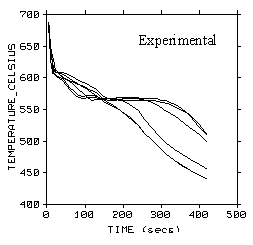
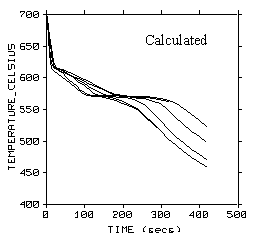 * J.A.Spittle et al in "Numerical Methods in Thermal Analysis IX", Pineridge Press, 1995, 455.
Mg, Al, Ca, Ce, Cu, Fe, La, Mn, Nd, Si, Sr, Y, Zn, Zr with data for the following phases.  It is a sister database to
Fe, Al, B, Co, Cr, Cu, Mg, Mn, Mo, Nb, Ni, P, S, Si, Ta, Ti, V, W, C, N, O with data for the following phases.
 Following standard Thermotech practice the database has been extensively validated against commercial alloys and results from this process indicate that a high level of accuracy has been achieved. For example, the figures underneath show comparison plots for Austenite percentage in duplex steels and the composition of M6C in high speed steels ‡. 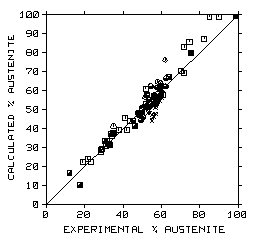
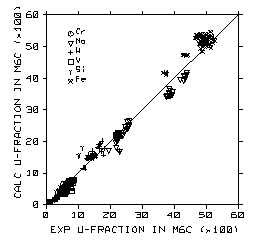 ‡ N.Saunders and A.P.Miodownik in "CALPHAD- A Comprehensive Guide", Pergamon Materials Series vol.1, ed. R. W. Cahn (Pergamon Press, Oxford, 1998)
Ni, Al, Co, Cr, Cu, Fe, Hf, Mn, Mo, Nb, Ru, Re, Si, Ta, Ti, V, W, Zr, B, C, N, O
with data for the following phases.  The database sets new standards for accuracy in thermodynamic calculations of multi-component alloys. It can be used for all types of Ni-based or NiFe-based alloys. As part of a validation process extensive comparison has been made with experimental results which demonstrate that this database performs at an accuracy close to that expected of the experimental measurements themselves †. The figures underneath show a phase% plot for a U720 alloy and a comparison between experimental and calculated critical temperatures for a wide variety of alloys. 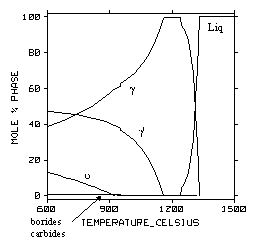
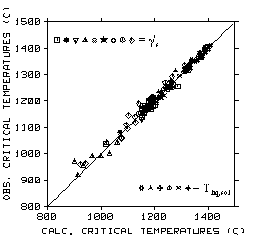 †N. Saunders in "Superalloys 1996" eds. R.Kissinger et al. TMS, Warrendale PA, 1996, p 115
Ni, Al, Co, Cr, Fe, Mo, Mn, Nb, Si, Ti, Zr, B, C, N
with data for the following phases.
 NiFe-based superalloys can behave in a more complex fashion than predominantly Ni-based alloys. For example, the hardening mechanism often involves gamma", the metastable form of Ni3Nb. NiFe-Super has proved itself capable of handling these very complex alloys providing excellent answers for both stable and metastable equilibrium. Further it has been used with excellent success in solidification modelling of such alloys§. The current database is currently a subset of The figures underneath show a phase% plot for a 718 alloy showing the stable behaviour where Ni3Nb is formed and its behaviour under more usual hardening conditions where sluggish kinetics cause gamma" to form in preference to Ni3Nb. In these circumstances the alloy is hardened by a duplex precipitation of gamma' and gamma" which is clearly accounted for using NiFe-Super. 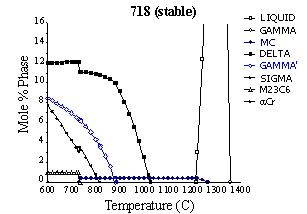
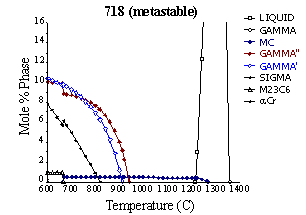 § N. Saunders, M. Fahrmann and C. J. Small in "Superalloys 2000" eds. K. A. Green, T. M. Pollock and R. D. Kissinger (TMS, Warrendale, 2000), 803
Ti, Al, Cr, Cu, Fe, Mn, Mo, Nb, Ni, Re, Ru, Si, Sn, Ta, V, Zr, C, O, N, B
with data for the following phases.  Calculations using The figures below shows the comparison between experimentally measured and calculated beta-transus temperatures and the second the amount of alpha in a Ti-10V-2Fe-3Al alloy as a function of temperature+. 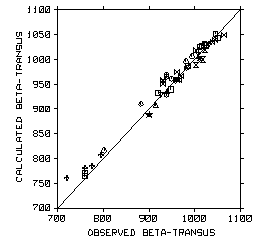
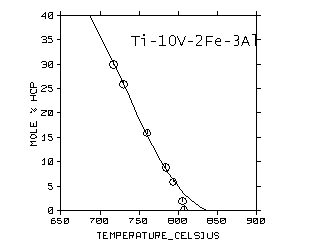 + N.Saunders in "Titanium 95: Science and Technology", ed.P.Bleckinsop et al. Inst. Materials London 1996, p2167
Ti, Al, Cr, Mn, Mo, Nb, Si, Ta, V, W, Zr, B, O
with data for the following phases.  This database represents a new state of the art in modelling techniques and includes features which allow, uniquely, the inclusion of O in the The new database is compatible with Ti-DATA which was designed for conventional 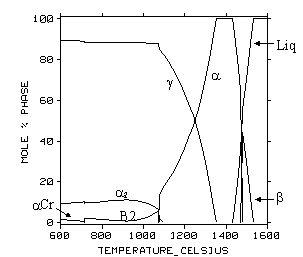
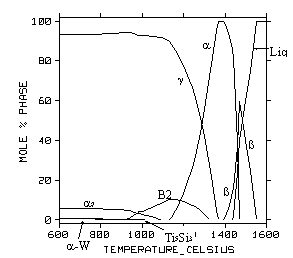
# N.Saunders in "Gamma Titanium Aluminides 1999" eds.Y-W.Kim et al., TMS Warrendale, PA, 1999 p.183 | |
|
About us
|
